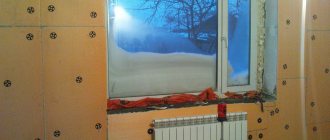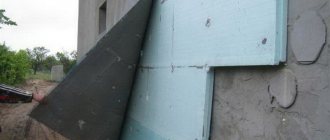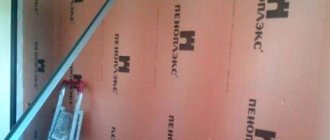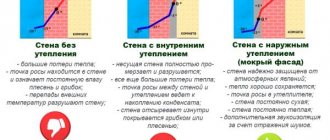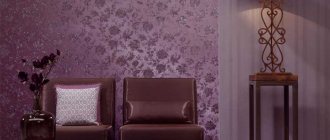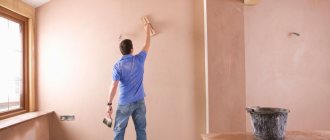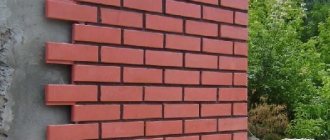Distinctive features of foam as a material
The insulation in question has a fairly low strength. When exposed to moisture and cold, the material can crumble into small balls. For this reason, it is not recommended to insulate the walls of a house with foam plastic from the outside without protective cladding. You can use this method indoors without fear.
Polystyrene foam as wall insulation has the following positive characteristics:
- low cost;
- accessibility, it can be easily purchased at almost any hardware store;
- light weight;
- ease of transportation;
- ease of installation;
- good thermal insulation performance;
- safety.
The disadvantages when used from the inside of the wall of a house practically do not appear, since the material is most afraid of moisture and freezing temperatures.
Advantages of polystyrene foam
Polystyrene foam is widely used in building insulation work. In terms of its technical characteristics, it differs positively from other thermal insulation materials.
Price
The price of polystyrene foam in construction stores may vary depending on the density of the insulation, the size of the material, brand and manufacturer.
Compared to analogues on the market, polystyrene foam is an inexpensive material.
Ease of installation
Polystyrene foam is lightweight. This advantage is due to the fact that it consists of more than 90% air. The material can be easily cut with a knife or hacksaw, and the necessary holes can be made in it. The elements fit together without any extra effort, the surface has good adhesion. Installation does not require the use of complex equipment.
Polystyrene foam is easy to install.
Life time
The practice of using polystyrene foam indicates its durability. It can withstand physical stress and does not collapse under pressure. If the insulation is of good quality, the rules of installation technology are followed and protection from negative factors is carried out, it can last more than 30 years.
Environmental friendliness
Polystyrene foam is an environmentally friendly building material. It is odorless and does not emit harmful substances. The polystyrene foam contains no carcinogens. It almost does not interact with air and water.
The material is safe for human health and must be completely recycled.
Hydrophobicity
Due to its structure, the hydrophobicity of the foam is minimal. When immersed in water for a day, the absorption of liquid by the material does not exceed 3%. When interacting with water, the foam does not change shape and does not collapse.
Pros and cons of insulation from the inside
Before doing the work yourself, you need to study all the nuances. Thermal insulation of indoor walls is not the right solution from the point of view of such a science as heating engineering. This method becomes only acceptable if it is impossible to use another. The disadvantages of insulating the walls of a house from the inside are as follows:
- reduction of usable area of internal premises;
- the measures taken do not prevent the walls from freezing, and therefore do not protect them from destruction;
- the point of dew (condensation) appears inside the load-bearing wall of the house (there is a high probability of moisture accumulation).
The dew point is at the junction of the wall and the polystyrene foam, so in order to avoid condensation, it is extremely important to apply a vapor barrier.
Insulation with polystyrene foam from the inside can only be done if there is a serious need for it. Most often, DIY work should be done in the following cases:
- Thermal insulation of premises in a multi-storey building. To insulate an apartment with polystyrene foam from the outside, you will need to hire industrial climbers. Such services are expensive, so an alternative option is to use protection from the inside.
- Insulation of house walls with new cladding. When doing work with your own hands in a private house, it is necessary to take into account the condition of the facade finishing. If the external work was completed relatively recently, dismantling the cladding is not practical from an economic point of view. In this case, it is also possible to fix the thermal insulation from the inside of the walls.
Pie wall when using polystyrene foam
Internal insulation using PPS does not require the creation of a complex multi-layer system. The fact is that from a physical point of view, any additional layer will only be a hindrance, creating an obstacle to the movement of steam, or it will simply be useless.
The usual composition of the pie looks like this:
- Wall material.
- Leveling layer of plaster. (not necessary).
- The insulation layer is in our case EPS or EPS.
- A layer of vapor barrier film (optional).
wall pie
A leveling layer is needed if there are significant flaws on the inside of the wall - dents, potholes or curvature of the surface. The norm is 1 cm per 1 m of surface; everything that exceeds this ratio must be plastered. In addition, a layer of plaster increases the thickness of the wall and, as a result, to some extent increases its thermal resistance.
A vapor barrier film is an additional measure; when using materials with high vapor permeability, it is required. But, since EPS itself is a vapor barrier, and EPS does not allow steam to pass through at all, the presence of a film will only be an additional insurance.
PLEASE ATTENTION! For the correct action of the cake, you need to know the principle of constructing layers for internal insulation: the vapor permeability of the layers, counting from the inside, should be in descending order.
This facilitates the removal of steam that has passed through the insulation and lost a significant part of the partial pressure energy through the wall material.
Do you need hydro- and vapor barrier?
The presence of waterproofing in a wall pie using EPS is not required . Vapor barrier is present in the form of the insulation itself, which in itself is an excellent insulator, although in exceptional cases, when the room has a high content of water vapor, a layer of vapor barrier is laid on top of the EPS layer.
At the same time, simultaneously with laying a vapor barrier or insulation, it is necessary to take care of high-quality ventilation in order to organize the replacement of internal air and the removal of steam to the outside. Then the house will become much more comfortable, in addition, the passage of vapors through the cake material will be reduced.
Insulation inside
Before you start insulating the walls of a private house with foam plastic inside, you need to pay close attention to some details:
- the presence of gaps between the door (window) openings and the wall. If there are any, they must be eliminated urgently;
- window tightness;
- quality of the heating system (if the batteries are old, they will have to be replaced or sections added).
Preparing the walls in the case of insulating the house from the inside with polystyrene foam is identical to the preparatory work on the outside: we level the walls, remove the old putty and paint, remove all the nails and screws, and wash the wall surface.
The list of tools and materials is similar:
- Styrofoam;
- antifungal putty;
- cement-based glue or adhesive;
- "umbrellas";
- mesh and tape;
- roller;
- spatulas;
- drill.
The surface to be insulated must be dry, level and clean - a universal requirement for such types of work.
It is customary to start installing foam plastic inside from the bottom far corner. Holes are made in the slab and an “umbrella” is driven in. There should be an average of 5-6 “umbrellas” in one sheet of foam plastic, and the cap of each one should fit snugly to the surface of the foam plastic (not stick out or “sink”).
Judging by the experience of most owners who have insulated a private house with polystyrene foam, it is most inconvenient to install the last insulation element in a row - it must be adjusted to size.
When the insulation is applied, the seams and caps of the “umbrellas” are masked. Regarding the seams: if they are narrow, then they are simply blown in with foam, and wider gaps are filled with foam cuttings.
IMPORTANT! To insulate walls from the inside, it is better to use thin sheets of polystyrene foam - 20-25 mm. This way you won’t “steal” the place.. Reinforced tape is applied to the finished wall and attached with adhesive, then a mesh
There is one peculiarity in fixing the mesh to the wall: it is embedded in glue, and after drying it is treated with sandpaper
Reinforced tape is applied to the finished wall and attached with adhesive, followed by a mesh. There is one peculiarity in fixing the mesh to the wall: it is embedded in glue, and after drying it is treated with sandpaper.
The final stage is decoration.
Brick house Often it is brick houses with thin masonry walls that need insulation. And often it is brick walls that are insulated with foam sheets.
In this case, the insulation is secured with adhesive mixtures. They are preferable because of their ability to “cling” even to a not very prepared surface. Although here, too, the element of economy must be taken into account: if the brick mill is leveled and prepared, then the consumption of the mixture will be correspondingly lower.
Is it worth doing internal insulation with foam plastic?
Newbies often ask on forums: is it possible to insulate a house from the inside with polystyrene foam?
To be honest, I am generally against insulating walls from the inside for the following reasons:
- This operation isolates the walls from internal heating, as a result of which they stop heating. This even leads in some cases to cracks in the walls. ;
Layout of the dew point for internal thermal insulation of walls
- The dew point moves towards the room, as a result of which moisture forms between the insulation and the wall. This also negatively affects the durability of the walls;
- the floor and ceiling overlap are in contact with the cold walls, as a result of which they serve as a cold bridge. True, this drawback only appears if the floor is concrete, because concrete, as is known, has high thermal conductivity;
- The insulation of the house, although insignificant, still reduces the usable area inside the home. For small houses, for example, garden houses, this drawback can also be critical.
Therefore, most often the walls are insulated indoors if it is not possible to perform this operation outside or, for example, it turns out that external thermal insulation is not effective enough.
As for polystyrene foam, this insulation is also not the best choice for internal thermal insulation for a number of reasons:
- expanded polystyrene is a fire hazardous material;
Expanded polystyrene burns well
- in the event of a fire, the foam releases toxins, which leads to poisoning of people inside the building;
- has zero vapor permeability, as a result of which, after insulation, the walls stop “breathing”. Therefore, housing needs high-quality thermal insulation.
A good alternative to polystyrene foam is extruded polystyrene foam, which is often fireproof due to the presence of a fire retardant in its composition.
Therefore, I do not recommend insulating permanent residences with foam plastic. But if you need to insulate a country house that is used from time to time, or a balcony, then in general polystyrene foam is a good option.
The fact is that, for all its shortcomings, it also has some important advantages:
- low price - you can find polystyrene foam at a price of 1500-2000 rubles per cubic meter;
- excellent thermal insulation qualities - the thermal conductivity of expanded polystyrene is even lower than that of its competitor - mineral wool.
Frame wall insulation scheme
Features of using polystyrene foam as insulation
When securing material from the warm air side, special attention should be paid to safety. It is worth considering several disadvantages of insulating walls with polystyrene foam, which can be combated at the construction or renovation stage. These disadvantages include:
- flammability;
- low vapor permeability;
- the need for additional vapor barrier;
- the likelihood of a greenhouse effect occurring indoors with insufficient ventilation.
To prevent the risk of fire, strict compliance with all fire regulations is required. When choosing a material for thermal insulation of the walls of a house from the inside with your own hands, you should give preference to those types that are highly resistant to fire. The flammability group is indicated by the letters:
- NG - non-flammable;
- from G1 to G4 - varying degrees of flammability.
The higher the number on the label, the more dangerous the material is offered. In the store, it is recommended to choose the foam that has the lowest degree of flammability of all those presented. You can additionally consult with the seller.
To prevent the appearance of mold and mildew on the walls, it is necessary to move the point of condensation from the surface of the connection between the wall and the insulation. The thermal insulation material is attached to the wall from the inside with your own hands without any gaps. This way you can avoid problems with condensation.
The most important task when using polystyrene foam as a heat insulator is to ensure the necessary air exchange. If there is insufficient ventilation of the premises of the house, the microclimate is disrupted. There may be problems with humidity and indoor air temperature. To prevent troubles, you need to think about ventilation at the building design stage.
To prevent condensation, use the following techniques (simultaneously):
- a small ventilation gap is provided between the wall insulation and the interior decoration;
- a vapor barrier is attached on top of the insulation;
- carry out measures to install a forced air ventilation system.
The most reliable insulation scheme from the inside
If you take into account all the features of foam plastic as a building material, you can use it for the wall of a house without fear. Installing thermal insulation with your own hands requires attention to every detail and adherence to the technology for performing the work.
Important! We strongly recommend creating a gap between the vapor barrier and the finishing layer. Because only this - and no other - method will 100% avoid the formation of condensation and the inevitable re-repair.
Is it possible to insulate residential premises with polystyrene foam?
Before deciding on a method for how to insulate walls, most people hesitate for a long time and often ask the question whether it is safe to insulate walls with foam plastic from the inside of a building. Moreover, many people have heard of multiple cases of fires, when insulation caused death and severe poisoning of people with toxic combustion products.
You can use polystyrene foam to insulate walls, especially if we are talking about a room with concrete walls located in the basement and ground floors. The effectiveness of using polystyrene foam as a heat insulator from the inside will be no lower than if you line the external walls of a building. Moreover, this method has its advantages:
- The service life of foam plastic increases by 15-20%, the slabs are less susceptible to destructive temperature changes and solar ultraviolet radiation;
- Noise and sound insulation is significantly improved, since most of the street noise penetrates not only through walls and windows, but also through all elements of building structures;
- The cost of insulating walls with foam plastic from the inside will be 10-15% less due to the smaller area.
Important! The main question is not whether polystyrene foam can or cannot be used, but how to insulate a wall with polystyrene foam indoors, making it safe for people.
Today, as a real alternative to polystyrene foam, only extruded polystyrene foam can be used, which, in fact, is not much different from its counterpart in terms of fire safety and toxicity. Options for arranging insulation inside the house with mineral fiber mats are not allowed due to the high content of phenolic resins and aromatic compounds.
How to make wall insulation with foam sheets the safest
If you take an interest in the methods and schemes for wall insulation in developed countries, you can see that polystyrene foam and expanded polystyrene are widely used for thermal insulation both outside and inside the building. The safety of using polystyrene foam as an effective means of insulation is achieved by three conditions:
- Foam insulation laid on internal walls must be covered with finishing made of non-combustible materials, such as mineral plasters and plasterboard sheets;
- Electrical wiring inside the room is laid in safe steel hoses with fiber padding;
- To insulate the surface of the walls, high-quality foam plastic sheets are used, which have been certified and tested for residual content of toxic substances.
For your information! Often, foam plastic is purchased on the market for insulation, which is generally not approved by sanitary standards for indoor use, and often does not have basic hygiene certificates.
In addition, most rooms, both with and without foam insulation, are equipped with sensors that respond to combustion and decomposition products of polymers, so the risk of the formation of toxic and poisonous gases is practically reduced to zero. Moreover, according to fire statistics, ignition of the foam insulation system occurred in cases where the installation of insulation was carried out in gross violations of the rules and technology.
Technical characteristics and fire resistance
Manufacturers of extruded polystyrene foam provide the buyer with a large list of positive characteristics and properties that distinguish the material from its relatives. But in fact, they also hide many nuances.
Let's look at environmental safety. Since EPP can serve for a long time without changing its technical parameters, it would seem that the material is absolutely safe. But it is not so. Each insulation has a certain period of time, after which the material begins to “age”.
As a result, caustic vapors and substances are released into the environment. The same substances are released when extruded polystyrene foam is heated to 80 degrees Celsius and above.
Now fire safety. Manufacturers claim that the material extinguishes immediately after the fire stops. And this has actually been confirmed in laboratory conditions, where there are no other finishing materials or elements of the main structure. But in practice everything is completely different.
There are other materials around extruded polystyrene foam that, if they do not support combustion, can heat up to high temperatures, which will cause the insulation to catch fire. In addition, it is impossible to immediately stop the access of fire.
Small pockets may remain under the casing, which will swell again and again with air currents. And the amount of smoke that is generated during the smoldering process of EPP cannot be compared even with burning rubber.
In some cases, manufacturers embellish the reality, and in others they draw conclusions solely on the basis of laboratory tests. Extruded polystyrene foam is a good insulator and has the right to exist in the modern world. But you don’t always have to rely on absolutely all characteristics.
Where is EPS used?
This thermal insulation material has gained wide popularity not only among private developers. It is used not only for insulating buildings. Highways and heating mains are protected from heat loss and icing with this universal insulator. But still, what interests me most is how EPP sheets are used to insulate residential buildings.
Thermal insulation of walls outside
For external insulation, extruded polystyrene foam is suitable if the walls of the main structure do not allow vapor to pass through in the same way as the insulation. If the walls “breathe,” you will have to build forced ventilation or replace the windows with ones that have slot ventilation.
The insulation must be covered with finishing material, which will embellish the facade and protect the insulator from exposure to sunlight. The EPP is fixed both mechanically (dowels) and with adhesive.
Internal wall insulation
Insulation of a house from the inside is chosen extremely rarely, and even less often with the use of extruded polystyrene foam. Except for one thing. To prevent heat loss through the roof, the use of EPP is suitable. All thanks to the following characteristics:
- Low moisture absorption coefficient is very important for roofing.
- Good strength characteristics.
- Lightness of the material.
Thermal insulation of hollow walls
Here the insulation is used together with an additional wall made of facing bricks. The material is fixed using anchors. The heat insulator is put on the anchor and pressed with a washer, the other end is hidden in the facing wall.
Floor insulation
Extruded polystyrene foam is used to insulate floors both in private homes and in multi-storey buildings. The material does not absorb moisture and does not allow cold to pass through, so it does its job perfectly. Heated floors or concrete screed can be laid on EPP slabs.
Is polystyrene foam harmful or not to human health?
What insulation should you use to avoid turning your home into a time bomb? After all, any thermal insulation material, with the exception of moss or flax, which is used to insulate wooden log houses, is a synthetic material, which means it contains toxic substances that are potentially dangerous and can harm human health. Particular discussions among users are caused by such questions as “is polystyrene foam harmful as insulation indoors” and “does the harm of extruded polystyrene foam exceed the harm caused by compressed polystyrene foam (ordinary polystyrene)”?
Is the buyer doing the right thing by giving preference to such an easy-to-use, relatively cheap and popular polystyrene foam?
It is dangerous for health to insulate a balcony from the inside with polystyrene foam
Preparatory activities
When installing polystyrene foam wall insulation with your own hands, you will need the following tool:
- fine-toothed hacksaw or string;
- sharp knife;
- scissors, rubber and metal spatula;
- paint roller;
- paint brush;
- construction mixer;
- measuring container for preparing glue;
- tape measure, metal ruler;
- plumb line;
- construction level.
Thermal insulation of walls from the inside with polystyrene foam includes the following main stages: preparing the wall surface, attaching polystyrene foam to the wall, applying finishing coatings. The entire technological process can be seen in the video. At the preparatory stage the following activities are carried out:
- Preliminary preparation. Insulating a house begins with thoroughly cleaning the surface of the walls. It is necessary to remove the previous coating, especially paint and varnish materials. This is important because the solvents present in such coatings can destroy polystyrene foam. A complete inspection of the condition of the wall surface is required, and if necessary, large damages are repaired; large cracks can be filled with polyurethane foam.
- Surface leveling. A smooth wall is an important condition for high-quality finishing of a room. In the case of brickwork, plastering will be required, but if there are concrete walls, you can do without it. In any case, preliminary preparation includes fine leveling. It is provided in the following order. An acrylic primer is applied to the wall surface, for which you can use a paint roller. After drying for 21-24 hours, all irregularities on the surface are eliminated using a putty composition. Surface preparation ends with the application of another primer layer. An antifungal ingredient is usually added to the finishing primer.
Preparation for work
To carry out work on insulating polystyrene foam from the inside, you will need a set of tools, including:
- Dowel – nails or dowel screws with a metal core and a thermally insulated head.
- Smooth and serrated spatula.
- Carpenter's knife and hacksaw with fine teeth.
- A screwdriver or drill with an attachment for stirring glue.
PLEASE NOTE: thermally insulated dowel heads are needed to ensure that the metal core does not serve as a cold bridge.
A set of materials for insulating foam from the inside:
- Primer that increases adhesion;
- Reinforcing fiberglass mesh.
- Adhesive composition from dry construction mixtures or foam glue.
- Wooden beam with a thickness of 40 mm and a width corresponding to the thickness of the thermal insulation boards (according to calculations).
- Expanded polystyrene.
- Vapor barrier film.
- Finishing materials.
IMPORTANT: When purchasing materials, consider the area of the slopes of windows and external doors.
Before performing foam insulation indoors, it is necessary to prepare the base: the walls must be cleaned of paint, paint, oil stains, solvent stains, and peeling plaster. The adhesion strength of the plaster to the wall is determined by tapping it with a mallet.
Treat the peeled areas with a primer that increases adhesion and plaster again. We check the evenness of the surface with a plumb line and a building level. After the plaster has dried (as recommended by the manufacturer), apply another layer of primer with an antifungal component, and you can begin insulating the wall with foam plastic.
Installation of insulation
After completing the alignment of the wall, the question of how to attach polystyrene foam is resolved. In general, the following instructions for installing insulation can be suggested:
- In order to secure polystyrene foam boards to the wall, a special adhesive mixture is used. The composition is purchased dry and prepared by mixing with water immediately before finishing work. The thickness of the glue should be optimal.
- The adhesive can be applied with a brush or roller to the wall surface or applied to the corners and edges of the polymer sheet.
- Installation of slabs starts from the bottom. They are first cut to size and applied to a dry wall. Cutting polystyrene foam is done using a well-heated string or a hacksaw with fine teeth.
- Having installed the first row along the entire wall, you can begin laying the next row. The slabs in it are shifted relative to the lower sheets in such a way that the seam between the sheets of the first row falls in the middle of the upper slab.
- Drying of the adhesive composition is ensured within 34-42 hours under natural conditions.
- It is advisable to additionally secure the installed insulation with dowels. To do this, the wall is drilled directly through the plastic, after which the plastic dowel is driven in. Thermal insulation is attached using self-tapping screws. Large polystyrene foam sheets are fixed at 6 points: in all corners and 2 dowels in the middle part.
- Sealing seams. If the seams between the sheets exceed 30 mm, then pieces (trimmings) of polystyrene foam are glued into them. Finally, all seams are filled with polyurethane foam, which should not contain toluene, which can dissolve plastic. The excess mass is cut off with a knife, and then the seams are treated with adhesive.
Final stage
Thermal insulation made of polystyrene foam is covered on top with a layer that performs a protective and decorative function. The final stage includes the following work:
- Application of a reinforcing layer. Mechanical protection of the foam and improved adhesion is achieved by laying a fiberglass reinforcing mesh over the insulation. It is attached to the thermal insulation boards using an adhesive mass. A special grouting compound is applied on top of the reinforcing layer. After waiting for it to completely harden, sanding should be done using emery cloth.
- Application of protective coatings. The next step is laying waterproofing and vapor barriers. Waterproofing is usually applied only in rooms with high humidity (bathrooms, kitchens, toilets). Vapor barrier in the form of a roll material with a layer of foil is necessary for all rooms in order to prevent the accumulation of condensation on the surface of the thermal insulation.
- Plastering walls. Most often, the finishing coating of walls inside a house involves applying a plaster mixture. You can then paint it or stick wallpaper on it. The plaster is applied using beacons, which ensures the evenness of the wall. After the plaster composition has dried, it is recommended to apply a finishing primer, which will finally eliminate all defects.
Internal wall insulation with polystyrene foam is deservedly popular and is widely used in all regions of the country. The material has excellent thermal insulation properties and, if installed correctly, will provide warmth in a house or apartment for a long time.
Penoplex inside the walls
Frame houses
Penoplex as a wall insulation inside has found the most beneficial application. In a frame house, the main heat-protective function is assigned to it, and this material fully justifies itself. For internal wall insulation, the thickness of penoplex is calculated based on the climatic conditions of a particular region. For Moscow, for example, they recommend at least 100 mm for foam insulation inside the wall structure and 150 mm for the roof.
When building a frame house, to protect the insulation from external influences, it is usually necessary to have a vapor barrier film, a windproof membrane, and leave a ventilation gap for ventilation. Internal wall insulation with penoplex does not require their use during the construction of the frame. Almost zero moisture absorption, low vapor permeability combined with high density - these are the qualities of this insulation, thanks to which it itself protects from wind and moisture. However, despite the fact that there is penoplex inside the walls, it would not hurt to additionally insulate them from steam from the side of the room in order to definitely prevent the load-bearing wooden structures from getting wet. Penoplex insulation inside the wall, complemented by high-quality external finishing, ensures good heat retention in the house.
Do-it-yourself technology
Insulation of walls with polystyrene foam can be done independently, without special training or skills. There are the following methods of thermal insulation with foam plastic:
- Foam boards are attached to the wall, covered with a vapor barrier film on top, then a sheathing is made onto which finishing panels made of plasterboard or other materials are attached. In this case, careful treatment of the walls is not required; all defects are hidden under the finishing materials.
- The second method is less time-consuming and expensive, if the wall is smooth and does not require much leveling work. In this case, it is cleaned, processed, and the slabs are glued directly to the wall with a special mastic. Then finishing work is carried out.
Let's consider the second, simpler method.
Surface preparation
If the wall is painted and the paint layer is strong enough, then in this case you can simply clean the surface of dirt, fill cracks or uneven areas with putty, and treat it with an antiseptic to protect against the formation of mold. After this, you can glue the foam boards.
Alignment
When the wall is uneven and the paint is peeling off, you need to carry out the necessary work to prepare it:
- remove the entire paint layer;
- clean from dirt;
- level with plaster and putty;
- prime;
- treat with an antiseptic and only then glue the foam.
Most antiseptics are very toxic. Therefore, you need to work in a well-ventilated area, wearing gloves.
Insulation
Foam boards must be glued from the bottom row. Adhesive mastic is applied to each of them along the entire perimeter and a few more dotted strokes are made along the inner area. The slabs must be arranged according to the principle of brickwork, so that the vertical seam of the next row falls in the middle of the previous slab.
After 3 days, when the mastic has dried, you need to secure the foam to the wall with special fasteners with wide heads. There are 6 pieces for each slab (at the edges and in the middle). To speed up the work, instead of mastic, you can choose a special glue that dries in a few hours.
Sealing seams
When installing the slabs, there are gaps between them through which cold air will pass. Therefore, they need to be sealed with special compounds that, when dry, create elastic seams, or treated with polyurethane foam.
Then the seams need to be leveled, carefully cutting off the excess with a knife and sanded. Construction tape cannot be used, because it will not be possible to seal the cracks hermetically.
Reinforcement and plaster
To strengthen the insulation, you need to cover the wall with a painting mesh. To do this, glue is applied to the surface and a mesh is attached to it. After the glue has dried, plaster and primer are applied to the walls.
Decorative finishing
The treated surface can be painted with acrylic paint, wallpapered or decorative plaster applied.
Installation of insulation boards
After fixing the frame, they begin to insulate the walls with polystyrene foam with their own hands: coat each slab with adhesive around the perimeter, retreating 1.5–2 cm from the edge and applying dot glue markers on the back side of the slab in an amount of at least 5 pieces on the back side of the slab.
The slab is placed into a cell of the frame and tapped with a mallet or the handle of a spatula. Work continues after the glue has completely dried, about 2–3 days.
PLEASE NOTE: Using foam adhesive will save you two days as it dries in 2-3 hours.
The seams between the plates and the cracks must be carefully sealed with scraps of insulation, glue foam or polyurethane foam. It is impossible to use an adhesive composition for this purpose, as cold bridges will form.
Insulating the walls of a house with polystyrene foam from the outside - stages of work
The main task of covering the insulation of a brick wall with polystyrene foam on the outside with your own hands is to reduce energy costs necessary to maintain an optimal microclimate inside a residential building.
Preliminary wall preparation
First, you should inspect the surfaces to assess the scope of work. Identified depressions and cracks should be eliminated using a cement-sand mixture. If the walls are painted, the old layer must be removed.
To accurately insulate the walls outside a frame house, it is necessary to properly prepare the surfaces - eliminate uneven areas and dry wet areas.
We insulate slopes
Windows and doorways are the main areas of the area where significant heat loss occurs. Therefore, it is necessary to organize thermal insulation of slopes. This process consists of several steps:
- cleaning the surface from contamination;
- primer of slopes in two layers to improve adhesion;
- leveling by grouting;
- cutting insulation;
- applying a layer of glue;
- installation of slabs;
- foaming the resulting cracks;
- plastering.
Finishing can be done later when finishing the walls.
Pasting the cornice
Before insulation, the cornice should be treated. It is important to follow several rules:
- choose a material of minimal thickness so that it can adhere to the adhesive layer;
- you need to start gluing the insulation strips from the wall;
- First, the vertical elements are fixed, and then the horizontal ones.
When the cornice is covered, they move on to organizing vapor and waterproofing.
Vapor barrier and waterproofing when insulated with polystyrene foam
Even taking into account the fact that polystyrene foam is considered a vapor-permeable material, it requires the installation of a vapor barrier layer to prevent the formation of condensation in the voids between the wall and the insulation layer. An excellent solution is the use of membrane films. They are installed overlapping only on completely dry surfaces. If you are insulating wooden walls, the film can be secured with a construction stapler. When working with concrete or brick buildings, glue can be used to connect the films to the frame.
How to protect walls from dampness
As has already become clear, with such insulation, the formation of dampness is almost inevitable. Therefore, you should consider the basic rules that will help you cope with the question of how to get rid of dampness that appears as a result of freezing of the wall.
Thus, in order to eliminate dampness in the wall, it is necessary to use only vapor-tight insulation. This is where the first, most serious mistake of many people arises, namely, insulation with mineral wool using an additional layer of vapor barrier (which in reality is practically useless).
In addition, the complete absence of seams or joints during insulation becomes an important factor, since they also allow steam to pass through, and even in greater quantities than the material itself. And also any joints are a risk of condensation entering the room.
Thus, only good, and most importantly, proper insulation and ventilation will help in solving the question of how to remove dampness. In this case, the following absolutely do not fit the category of good and correct:
- Warm plaster.
- Cork covering.
- Mineral wool.
- Liquid ceramics.
The first two options can only be used as the last element of insulation, nothing more. Let us repeat, any insulation that is performed with vapor-permeable materials is absolutely not suitable.
Almost the best option for insulating walls from the inside in a panel house is to use polystyrene foam. Of course, it is also difficult to achieve maximum tightness with it, especially without using additional solutions, but it wins compared to other materials. Penofol is also a good choice, we will also talk about it a little.
Thus, in order to get rid of dampness in the house, as has already become clear, it is necessary to carry out high-quality insulation. And then we will look at how to make it and what you need for this.
Installation of foam plastic
Drawing a conclusion from everything said above, we consider the question of whether it is possible to insulate walls from the inside with polystyrene foam closed. Yes, you can. All that remains is to decide on the installation method. There are two of them and the choice depends entirely on the characteristic features of the walls, but first things first.
Method one: with dowels
For fastening insulating materials, there are special plastic dowels with a wide head. When driven into the wall, their lower part expands in a pre-drilled hole, and the slab is securely pressed against the base. Thanks to the wide head, such dowels can be used to attach not only polystyrene foam, but also soft insulation materials such as mineral wool.
The fastening process is very simple, and in order not to focus on it, we suggest you watch how to insulate walls from the inside with polystyrene foam with your own hands in a video. The video shows how quickly the installation is done, and that this does not require any special knowledge and experience.
By the way, if the walls of your house are built of wood, then this is the only method of fastening, and before you insulate the wooden walls from the inside with polystyrene foam, they must be thoroughly stained with a special impregnation, which will extend the life of the wood and will not allow it to rot due to the condensation that forms.
Method two: glue
This method is even simpler than the first. It is ideal if you need to insulate brick walls from the inside with polystyrene foam. Glue is applied to the slab and it is pressed to the base.
The setting time is about five minutes, so you will have to keep the sheet pressed for some time. This affects the installation time, but on the other hand, you do not need any tools at all except a trowel or a construction spatula.
By the way, the same glue that is used for installation is also suitable for insulating seams. After all the plates are fixed, the joints are rubbed with glue and allowed to dry. After which the final finishing can be done.
